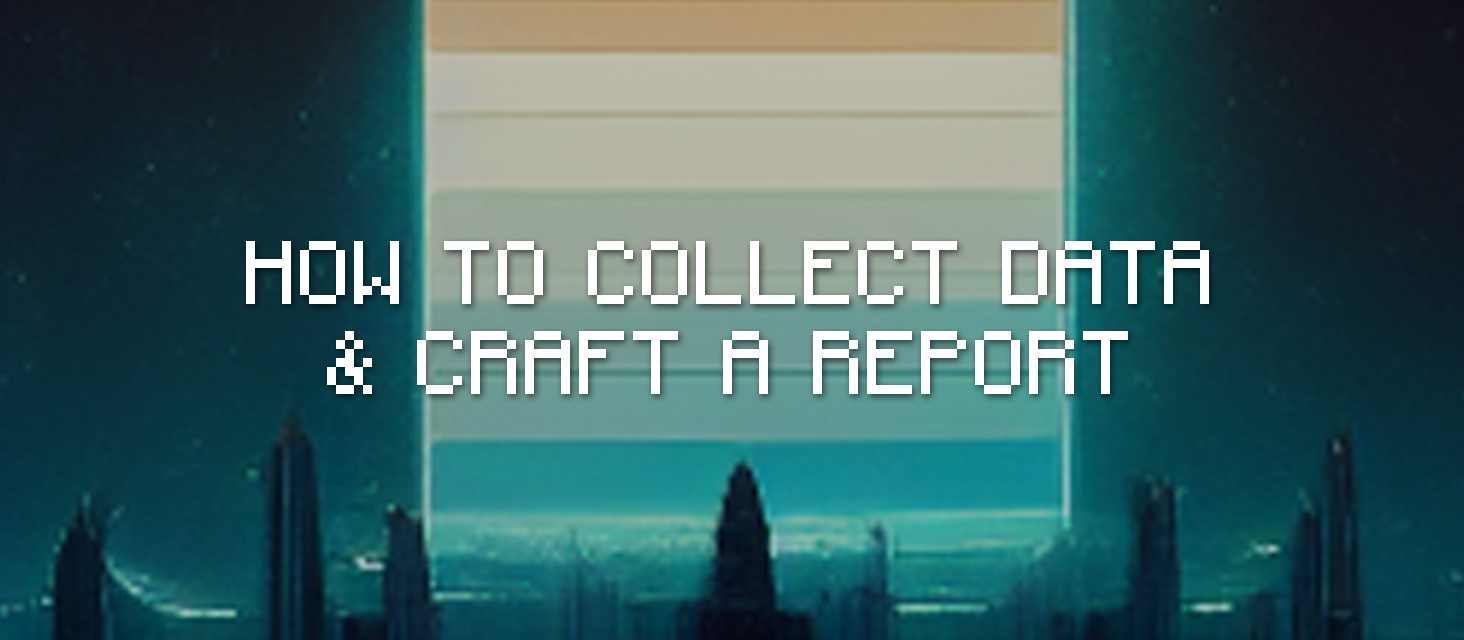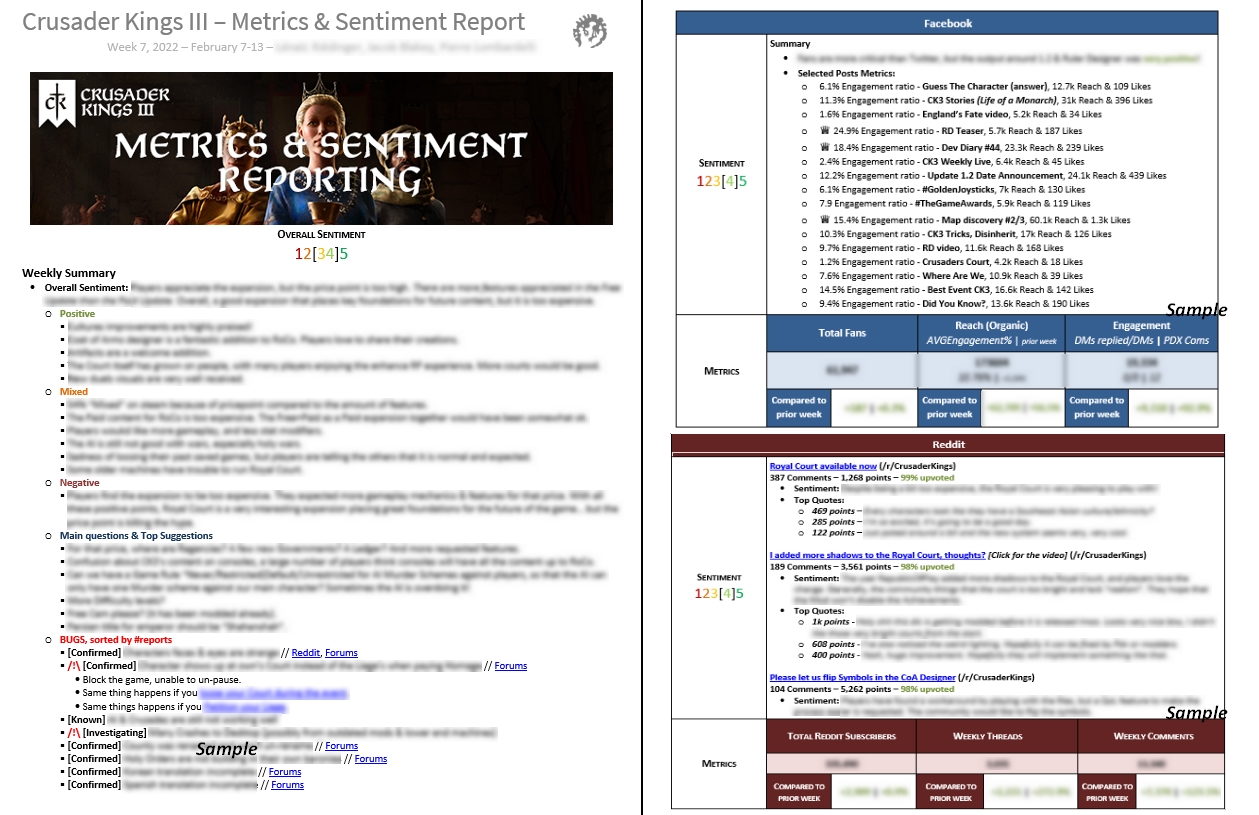How to Collect Data & Craft a Report
I hope that you enjoyed my first articles on CM Adventures; One piece of content every week!
Let me know what you think on Twitter, LinkedIn or via the comments here on Disqus 🙂
Now that I have an article on each of the categories I write about, this article will be a mix of SMM and CM: Data & Reporting!
- Social Media – Deconstructing Crusader Kings III: Royal Court Strategy
- Community Management – How to start a community
- Press & Influencers – Working with Press & Influencers
- Players – How to send Feedback & Bug Reports
Next time we’ll move again to Community Management, with How to Find & Manage Moderators for your community.
- Why are Reports so Important?
- What’s Inside a Report?
- How to Craft a Report?
- What does it look like?
- And the Data Collection?!
Why are Reports so Important?
Social Media Reporting is an essential part of Social Media Management.
The objective is a perpetual search for improvements in order to hone your Content and meet greater objectives.
▲ Usually, the Reports contain two things that must be weighted with clear quantitative & qualitative results:
- Sentiment
- How is the community doing
- Their main discussions about topic A
- Do they like or dislike your recent news & content?
- Metrics
- Measure the community’s growth
- How many comments about topic A
- What portion of the community like or dislike your recent news & content?
When you Report about the community, it helps not only yourself, but also your colleagues, management, and the community itself.
- By analysing the community regularly: you will have a better understanding of how your strategy is performing, and you will be able to tweak it in order to do better
- Your colleagues will also pick up interesting information from that report, and contribute with their comments, possibly tracking issues, and fixing them for a future update.
- Management is happy to see numbers going up, and a pretty visual Report.
- And the community of course, you support them by listening to their comments and escalating them to the development team.
💡 Here are a few tips that will help you when developing a Report:
- Use simple terms & write legends: While YOU know about technical terms, your coworkers might not understand what a Reach is, Paid Media, Engagement Rate…
- A visual document helps to better understand the information. Use images, icons, colour-coded tags, charts… and avoid the simple pie charts, it’s for noobs! 😛
- Prioritise the information: You must not report on absolutely everything the community is discussing about. Your job is to summarise it.
- Hierarchy: Sort the comments from the most important to the less important, but keep in mind that the less important are still “important to know” if it’s in your report.
- Do not make it too long: The longer it is, the faster your coworkers will be bored. It’s true. Each information must be relevant & interesting.
- There are no “I think that the community […]”: There are Data, facts, sentiment. Be precise about the feedback, possibly give advice to management about how to tackle an issue.
- Source: Always source your comments, provide a link to your team leading to the Thread, the Reddit Post, the YouTube video, the press article, …
What’s Inside a Report?
While I will mainly focus on a “Sentiment & Metrics – Weekly Community Report”, there are many types of Reports:
- Weekly Report: what happened this last week, gauge of the community sentiment, some metrics, analysis of your posts, feedback, bug reports, …
- Campaign Report: To detail a given campaign, its Key Performance Indicators, how it went and what could be improved (Post-Mortem)
- Crisis/Special Report: Recap of something important that happened like an Update for your brand or a big issue with the community.
- Benchmarking: Where you gauge similar brands & products compared to yours
For each of these reports, the content will of course be very different.
You must also take into account one of the most important specificity: Who will be reading this Report?
One of the first steps in building a great Report, is to ask the stakeholders what do they want to see in this Reports.
▲ Depending on these demands, your Report might propose:
- The community’s overall sentiment – How do they feel about your activity?
- Your social Media’s growth – To see if the chart is going up, and why it goes up, analysis of the spikes up/down
- Data for each of your posts on social Media – Likes, Reach, Engagement (Clics, Comments, Shares, …), Engagement Ratio (compared to Reach)
- Main Discussions – Detailed comments of the recurrent threads
- Positive, Mixed, Neutral, Negative bullet points – To better assess the debated topics
- Top Issues – If you categorise the topics discussed manually or via an online tool, it would help you quickly assess the main issues via a fancy chart
- Suggestions – Usually just one line with the suggestion and how popular it is
- Bug Reports – With the most critical/reported issues at the top of the list, details, platform, repro steps or a link to these information
- Activity Comparisons – For example to compare how DLC Campaign #2 for your product is performing compared to DLC Campaign #1
- Moderation Summary – If it is useful for your managers to know what kind of moderation you have done recently, and escalate names of troublemakers, and why did you action them.
- Content – Press Articles, YouTube videos, community guides and the main outtakes from them.
- Languages metrics – Who are the most active communities and the percentages? It could be helpful if you need a future dedicated Community Manager for these languages.
- …
Of course don’t put all of these in your Report! Tailor it to the needs.
💡 My Engagement Rate for a post is always compared to the Reach of that post (ERR); NEVER compared to the amount of Total Fans (ER Post). Because the algorithms sometimes work in mysterious ways, comparing to the Total Fans will give you ridiculously low Engagement Rates. Personally I want to know how many users have seen the post, and how many interacted with it. It gives me a better idea of “was the post interesting?”.
💡 If you want to assess your visibility, you can calculate the Engagement Rate compared to the Total Fan, but do keep in mind that a large portion of your fans might have not seen your post because of the algorithm didn’t favour it, maybe they’re on holidays, or just inactive, or bots, or eaten by a carp if you strolled too close to the pond…The metric doesn’t help you actually improving your posts, and it looks bad on paper.
ENGAGEMENT RATE % = (ENGAGEMENT / REACH) * 100
GROWTH RATE % = (PRESENT – PAST) / PAST
💡 Quotes from the most popular comments are interesting as a raw feedback from the community. Reword it slightly if it uses too technical terms, or if it has typos.
How to Craft a Report
I have crafted hundreds of reports — as a matter of facts 318 right now, something like 6 years of weekly reports — and one thing I can tell you is: Reports constantly change depending on the company, the needs, management, your needs, the community’s activity, and other factors. Be flexible, a report must not be fixed forever!
My process
Hello 2022, I’m done with sending Word .doc to a team: Let’s use GoogleDoc! GDocs allow you to work with a team, so you can fill the documents more efficiently without all the back & forth. Moreover, developers can directly leave comment on that report which makes for greater interactions between Community and Other Departments. It’s free, it’s all logged.
1) During the week, I read and bookmark noteworthy topics from the community when I visit the forums, Reddit, Steam Hubs, and other socials.
💡 An ongoing weekly document is used within the Community Team, so we can paste anything deemed useful for the next report.
2) Monday, my preferred day to fill Reports using sentiment & metrics from the past week. I like the smell of Reports in the morning.
💡 I usually open the last Report and create a copy of it. It is useful to keep as an up to date template with reminders of the things you wrote last week.
3) Metrics time, I’ll consolidate the data collected for the past week and review my charts
💡 I like to paste them in Photofilter (or Paint if you prefer, or any quick edit tool) so I can rapidly edit the images if needed.
4) Focussed Metrics, this is where I analyse all the posts we have shared last week: Reach, Engagement, Engagement Rates, Likes, Comments; To see if we performed well.
💡 Later, I can compare these metrics to improve the future content: better posting times, more of a particular content if it worked well, review tests, ideas, …
5) Sentiment time, the previous data I collected will also help me in understanding the sentiment.
Typically, I open dozens and dozens of tabs from all our social Media. Everything I deem interesting looking at the number of #Views, #Comments, and of course by reading the comments themselves if I think it is pertinent…
💡 At the end of this process, I also middle click a “TO KEEP” folder containing all the things my past-me deemed interesting from last week. And then by order of feedback quality preference I go through the Forums → Reddit → SteamHub → Discord → Facebook → Twitter → Instagram → YouTube → Tik Tok, …
► It is the most important part of the process: To sort all the information, prioritise them, and funnel the data & sentiment into a digestable document.
6) Once I have sorted my tabs and kept only the most interesting pieces, I will read the comments again and start putting the information into the Report.
► It is the longest part of the process, I must convey the information authentically in a digestable & comprehensible way.
7) Once that huge step is done, let’s review the document: reword sentences, make it visually more appealing, check if it is well sorted by importance, gauge the community sentiment, write a summary at the top, … and read your Report again. It must look pristine so your coworkers will want to read that every week: 🌻 A beautiful document centralising all the information they need to better perform at work.🌺
💡 I like to gauge the community’s sentiment from 1 to 5, first thing at the top. It gives the readers a sense of importance, as to how the report is presented this week.
8) Send the Report via Mail or via the steakholders’s preferred communications platforms like Slack for example.
Greet the team, write 1-2 line summary with the date and important information, cheers-thanks, give a link to the GDoc Report and also a .pdf attached.
9) Keep your GDoc & .pdf in a company folder to log the Reports.
10) Keep an eye for Developers’ comments, and interact with them if it is pertinent.
💡 They might be able to give you answers to be shared publicly, or worded in a way that can be shared publicly.
What does it look like?
There is no “Best Report”, it only needs to be tailored to your needs while also being sustainable in the long run.
Reports are long to assemble and require many hours throughout the week, so take some time here and there during the week to prepare your next Report.
It usually takes me between 5-8 hours of work to assemble a good Report on Mondays depending on the week’s content.
► I used to build Reports with boxes, it looks really neat but it sometimes give too much information that the dev team doesn’t understand or simply doesn’t care.
► Some data must be kept for your team only, so you can improve YOUR processes.
► This Report is for other teams to read, so present them with the info THEY want to read.
The three images below are only samples of reports I have produced, and don’t represent the entire reports. The data used here are also samples.
- Boxes, colour-coded, tags, focussed on metrics
- Sample data – Fans, Engagement, Milestones
- Text, colour-coded, tags, focus on feedback
And the Data Collection?!
Woops, I almost forgot about it.
Your Data, the metrics, can be collected via many tools.
Social media data analytics provide information that helps you understand what’s working, and what could be improved, to make the best decisions and refine your strategy as you move forward.
Engagement/Interactions (Clicks, Shares, Likes, Comments, …), Reach/Impression, Followers, Growth, Sentiment, Demographics, … are data that will help you understand your community and strategy.
Collecting Data natively from the social Media themselves can be quite tiring if you are not accustomed to Excel / GSheets.
If you prefer “good enough” data and less grey hair from stress: Use data collection tools!
- Hootsuite Analytics makes measuring brand awareness metrics easier by allowing you to track metrics from multiple social networks, all in one place. You can export the information or create custom reports to share with colleagues and stakeholders. The tool collects data from Facebook, Twitter, Instagram, TikTok, YouTube, and LinkedIn. There is also Hootsuite Insights to track the social Media sentiment, mentions, and hashtags. Hootsuite is master of analytics. It comes at a price, but compared to other tools, I find it to be the most cost efficient, flexible, and performant.
- Sprout Social is on par with Hootsuite, the two platforms have been battling for eons to be the Top1. Your choice to investigate, it might be slightly better to interact with users but frankly it’s all taste. Still I put it on my liste because it’s a good alternative depending on how you want to work.
- Let’s get manual baby! I like to suffer, so I collect my numbers manually. DIY style for full flexibility, accurate data, and exactly what I want to track.
- Because I spoil you, go ahead and copy my GSheet Data Collection.
- Then go to Facebook Insights (insert your page’s name), Twitter Analytics, Reddit Stats, and other metrics for Instragram Insights, Tik Tok Analytics, Discord Statbot, etc… For Steam I have never found a great tool to count #comments, so I count the number of comments manually to get a trend of ups & downs, every day. Help me.
- On a daily and weekly basis, go over the metrics you downloaded from the metrics pages, Excel sheets. Sort the information, put that into GSheet, and get your metrics & charts 🙂
- Metrics per posts can also be collected and noted on another document if you want, I used to input them directly in the Report.
Once you have your Data, well, take the most important KPI and put that into your Report!
Congrats \o/
💡 Because I can and it’s often debated: Data is the plural of Datum. Scenario is the singular of scenarii. Medium is the singular of Media. Thank you, have a good day.





